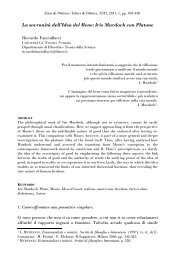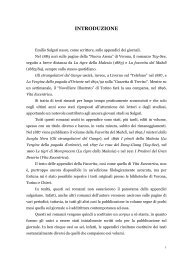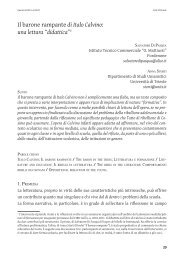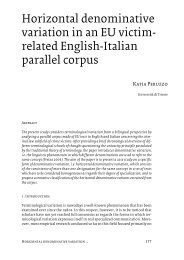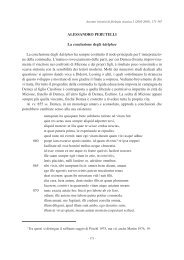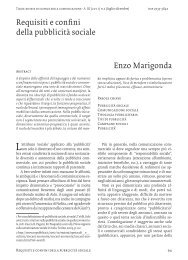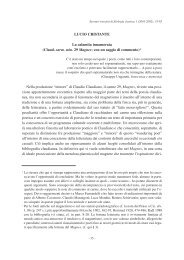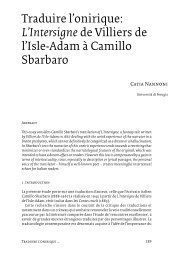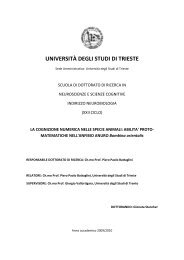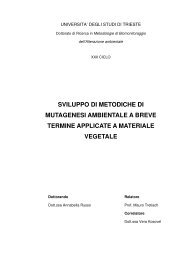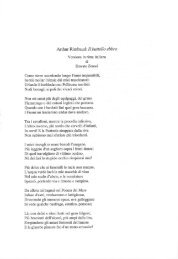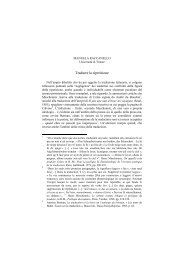Melchiorre Cesarotti e le trasformazioni del paesaggio ... - OpenstarTs
Melchiorre Cesarotti e le trasformazioni del paesaggio ... - OpenstarTs
Melchiorre Cesarotti e le trasformazioni del paesaggio ... - OpenstarTs
You also want an ePaper? Increase the reach of your titles
YUMPU automatically turns print PDFs into web optimized ePapers that Google loves.
Welsh bards slaughtered by Edward I with a suitably symbolic landscape of wild<br />
mountains, blasted trees à la Salvator Rosa, and the debris of geological time.<br />
Jones’ painting of 1774 is among the best and most interesting [Figure 7]: he sets<br />
the scene in mountains – the Snowdonia of Gray’s ode – into which he imports<br />
Stonehenge, which despite Inigo Jones’s earlier attempt to attribute it to the Romans<br />
was generally ce<strong>le</strong>brated as an indigenous and ancient druidical site. Jones<br />
captures the essence of Gray’s account of how the last bardic survivor, his col<strong>le</strong>agues<br />
having all been massacred by Edward, is about to thrown himself off a<br />
cliff; he translates the lines and captures the consonance of the landscape and the<br />
dramatic moment of bardic despair<br />
Loose his beard, and hoary hair<br />
Stream’d like a meteor, to the troub<strong>le</strong>d air<br />
….. each giant-oak, and desert cave,<br />
Sighs to the torrent’s aweful voice beneath.<br />
This image of some wild poet in his landscape is picked up in many other illustrations<br />
and commentaries on Macpherson’s poem: indeed some years later in<br />
1818 it was a combination of both Gray and Ossian that inspired Victor Hugo’s Les<br />
Derniers Bardes. If Narcissus had been the classical metaphor of an introspective<br />
response to landscape, now the bard or druid signal<strong>le</strong>d a sterner and more sublime<br />
correspondence, something that is articulated verbally in Ode on the Poetical<br />
Character by William Colins. 7<br />
The bardic landscape deserves its own extensive treatment, for which there<br />
is no room here; 8 such treatment would have to explore the who<strong>le</strong> revival of<br />
early celtic poetry, either in its imaginative forms like James Beattie’s 1769 The<br />
Minstrel; or, The Progress of Genius, its scholarly researches in Bishop Percy’s The<br />
Reliques of Ancient English Poetry of 1765, or the c<strong>le</strong>verly contrived midd<strong>le</strong> mode<br />
of Macpherson himself. In all cases the discovery of a new poetics was always<br />
closely related to what were for the 18 th -century largely unfamiliar landscapes,<br />
even ones to be feared and avoided – what Percy cal<strong>le</strong>d «solitary and mountainous<br />
country». 9 This cult of ancient bardic poetry, indigenous to the British Is<strong>le</strong>s<br />
in the days before its native culture was overtaken by the classicizing Renaissance,<br />
coincided with and probably encouraged a much increased tourism to<br />
picturesque-sublime areas like the Welsh mountains, Scottish Highlands, English<br />
Lake District or even the Derbyshire Da<strong>le</strong>s, to which new landscape paint-<br />
7 The Poems of Thomas Gray, William Collins, Oliver Goldsmith, ed. R. Lonsda<strong>le</strong>, London, 1969, pp.<br />
434-434.<br />
8 The reader is directed to the fourth chapter, The Landscape of the Bard in my The Figure in the<br />
Landscape, (see note 1).<br />
9 Ivi, p.150.<br />
10



